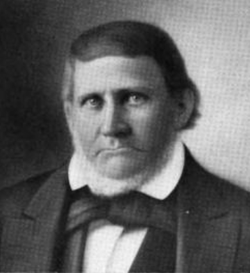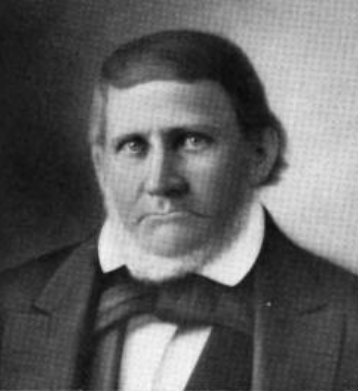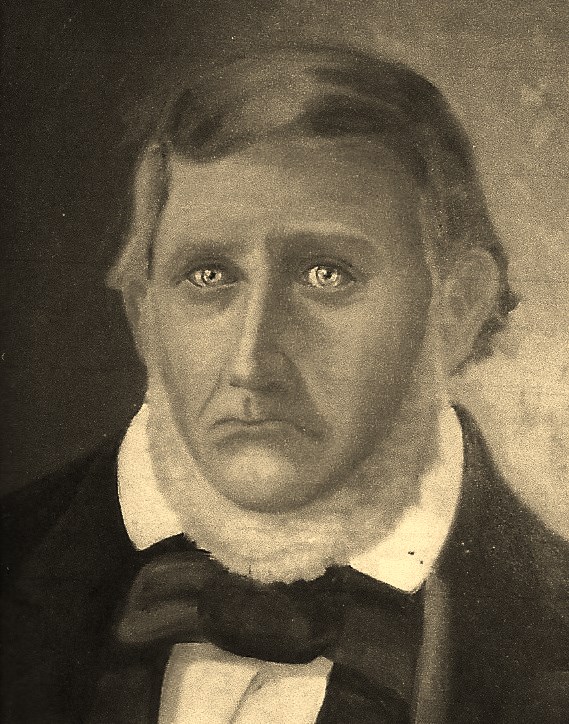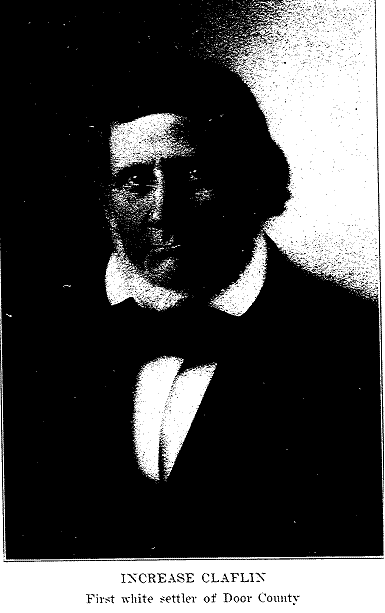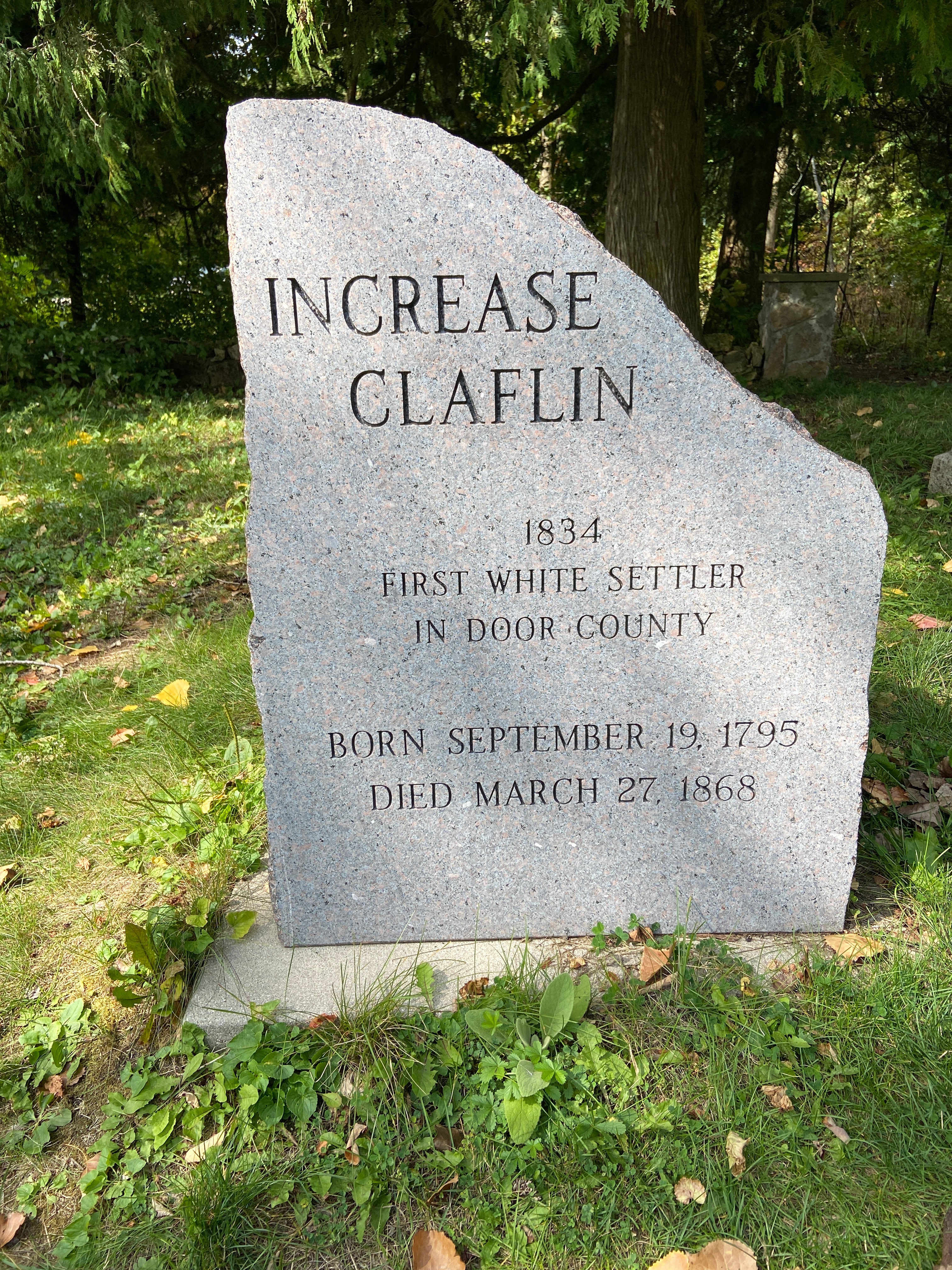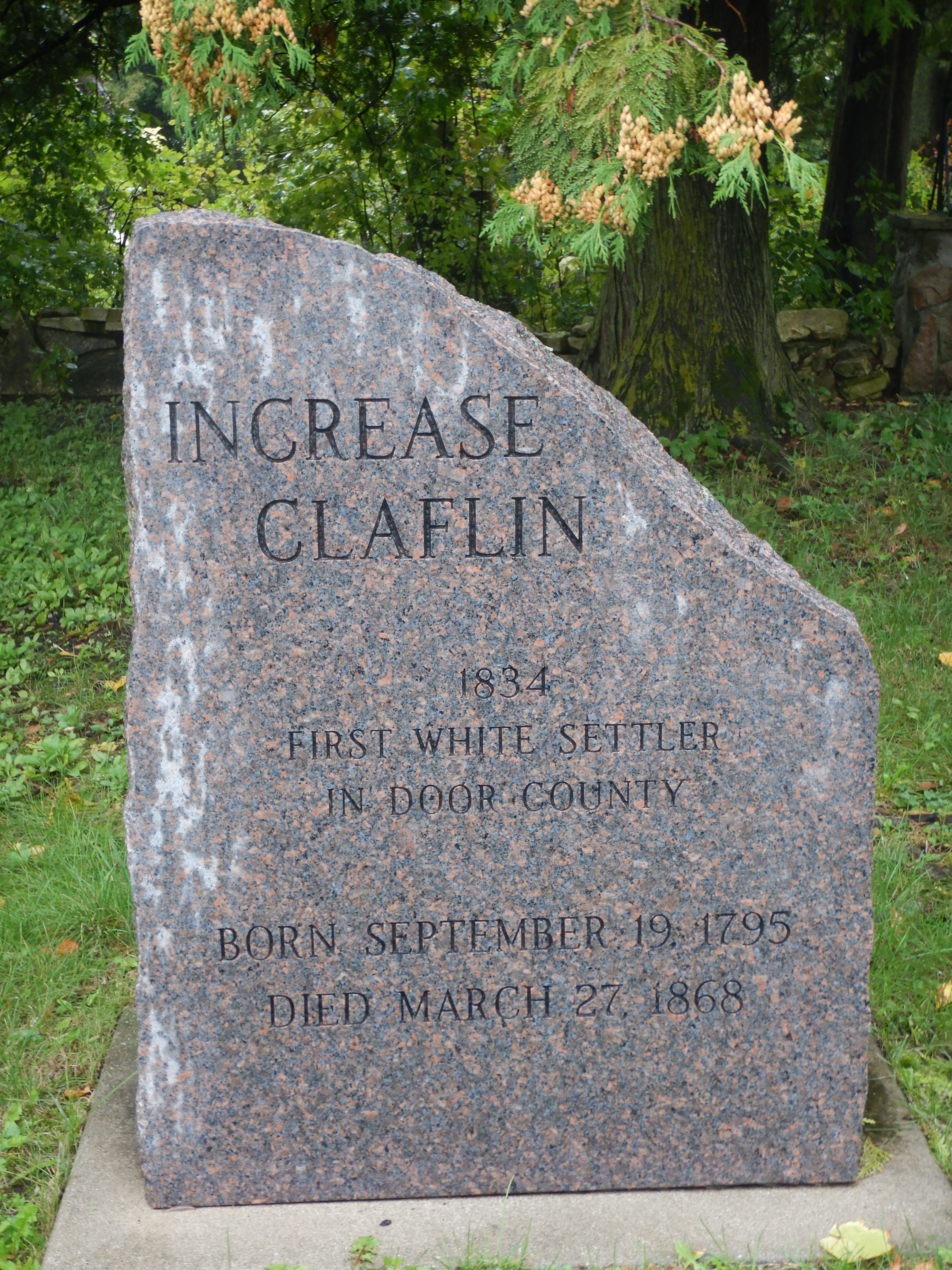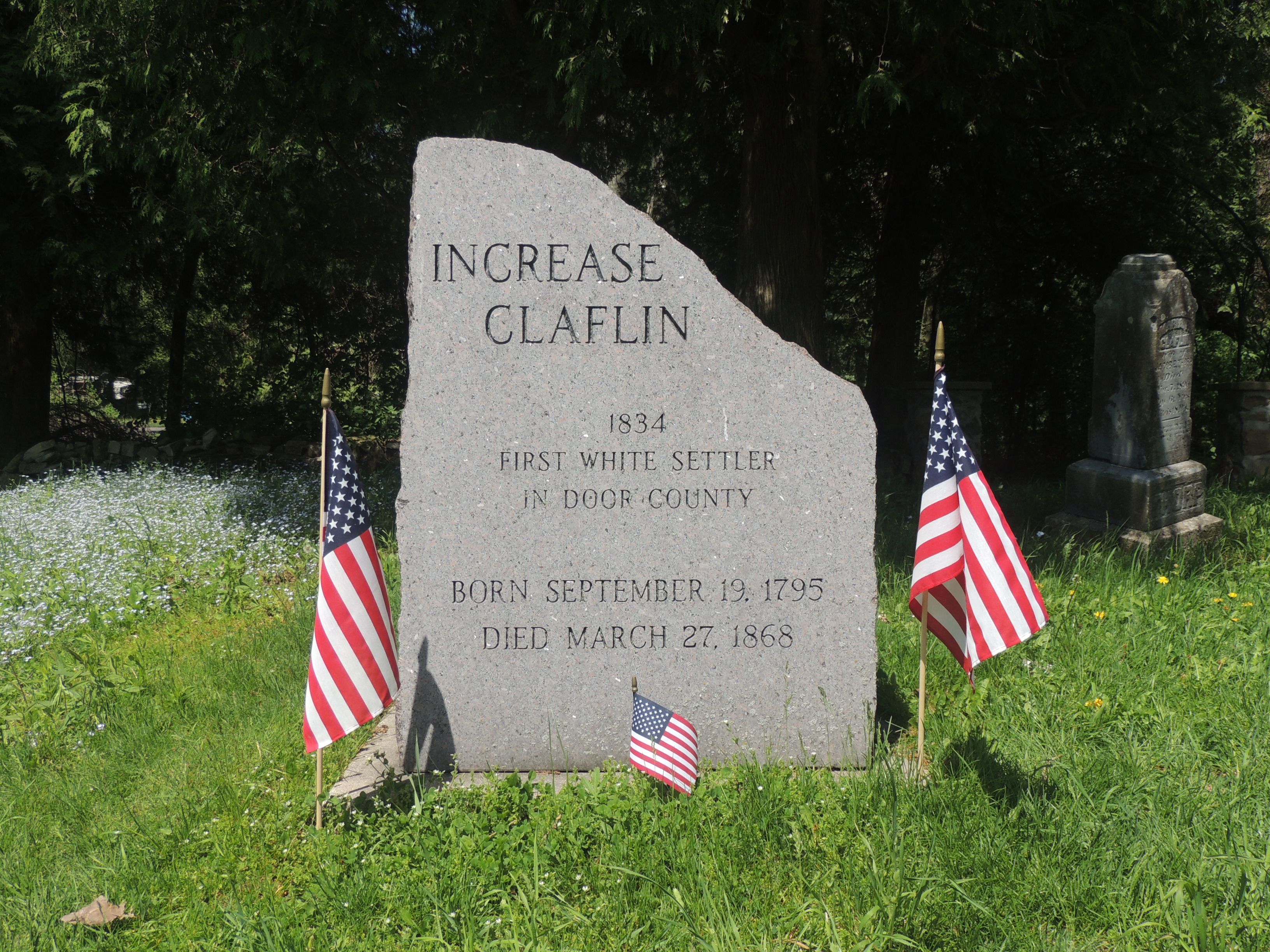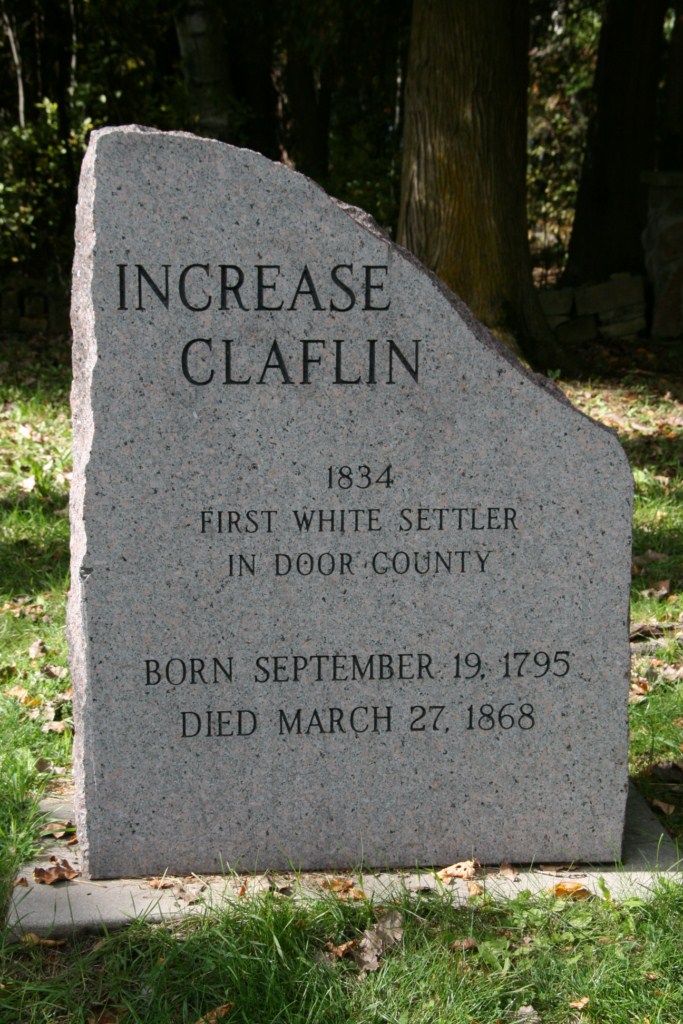Increase Claflin was born September 19, 1793, at Windham, N.Y., the son of Increase Claflin and Sarah Stimpson. His father, Increase Claflin, was born at Hopkinton, Mass., November 13, 1757, the son of Cornelius Claflin and Deborah Howe. He was a member of the Hopkinton Company of minutemen who responded to the Lexington alarm. On June 1, 1776, he enlisted in the Fifth Middlesex Regiment and served with honor throughout the Revolutionary War. His father, Cornelius Claflin, was born at Hopkinton, Mass., March 13, 1733, the son of Daniel Claflin and Rachel Pratt. He served in the French and Indian War and took part in the expedition against Crown Point in 1756. He also served throughout the Revolutionary War, being lieutenant in the same regiment in which his two sons served as privates. His father, Daniel Claflin, was born at Wenham, Mass., February 19, 1702, the son of Daniel Claflin and Sarah Edwards. His father, Daniel Claflin, was born at Wenham, Mass., January 25, 1674, the son of Robert Mackclathlan and Joanna Warner. The house that he built in which many generations of Claflins were born is still standing in good preservation. His father, Robert Mackclathlan, the founder of the large and distinguished Claflin family, came to America some time before 1661. Here his name was quickly simplified into Clafland, later Claflin. He was born in Argyllshire, Scotland, where, in Cowal, were the stronghold and large possessions of the Mackclathlans for centuries. The name is of Norse origin and it is supposed that the first Mackclathlan was a Norse viking who conquered that part of Scotland about the year 1000.
Increase Claflin, the subject of this narrative, was also a soldier like his father and grandfather. Unlike his ancestors, he was of a roving disposition. After serving in the War of 1812 we find him at Cleveland, Ohio. Later he transferred himself and family across the unknown wilderness of the South and took up his home at New Orleans, where he was a hospital steward in the service of the United States Army. Here his daughter, Adelia, later the wife of Robert Stephenson, was born Ju1y 24, 1821. Some time before 1830 he had found his way 1,000 miles to the north and located at Kaukauna, Wis., as a fur trader, his business being to buy furs for a New York house. There were only two or three white families at that time at Kaukauna which was the only settlement of white men between De Pere and Prairie du Chien. Mr. Claflin must at this time have had several men in his employ as the census of Brown County for 1830 gives the number of people in his household as thirteen. There is also a tradition that he took part in the Black Hawk War of 1832 in Southwestern Wisconsin, but this report I am not able to either verify or deny. About this time Mr. Daniel Whitney, for many years the leading business man of Northeastern Wisconsin, located in Green Bay and started many enterprises. In 1830 he platted the Village of Navarino which later became the chief business part of Green Bay. In many of Mr. Whitney's undertakings Mr. Claflin was employed by him as forman or overseer.
The first Government land office in Wisconsin was established in Green Bay. The first tract of land sold was to Increase Claflin and Darius Darnell July 30, 1835, being lot 1, section 8, town 22, range 20, lying just below the present village of Wrightstown in Brown County. Mr. Claflin did not settle here, however, but had by this time turned his steps in another direction. That highlying peninsula lying to the northeast of Green Bay with its deep, curving shores which the Indians described as their original paradise, had long attracted him. Finally in the spring of 1835 he loaded all his possessions on a Mackinaw boat and with a fair wind and fulsom hopes set sail for Little Sturgeon Bay. Here on the point of land at the mouth of the bay, on the west side, on exactly the spot now occupied by Charles Gustafson's modern home, he built the first house in Door County. Little Sturgeon Bay was then as now a most idyllic spot, abounding in all kinds of fish and game and a favorite resort for the Indians. On the opposite side of Little Sturgeon Bay, on what is called Squaw Point, there was a village of 500 Menominees. For a time Claflin got along very well with the latter as he treated them fairly and generously. Two or three years later serious trouble broke out between them brought on by Claflin's son-in-law, Robert Stephenson.
Mr. Stephenson, originally from Pennsylvania, came to Little Sturgeon in 1836 where he was employed by Mr. Claflin in various capacities. In 1837 he married Mr. Claflin's oldest daughter, Adelia, but continued for a time to make his home with the Claflins. Mr. Stephenson was an energetic, capable man but rather haughty in temperament. He despised the Indians for their slothful habits and did not think it beneath him to take advantage of the Indians when business opportunities were open. His favorite procedure was to get the Indians drunk, whereupon he would obtain their peltries at prices ruinous to the poor redskins. This displeased Mr. Claflin greatly as he was as fair to the Indians when drunk as when sober.
One day when Mr. Claflin returned from a journey an alarming sight met his eyes. A band of redskins in war paint were scurrying around his cabin. Robert Stephenson was engaged in a hand to hand fight with several Indians and was felled to the ground with several knife stabs. Another white man in the employ of Claflin lay dead in the doorway, and a couple of Indians were just dragging out his daughter, Mrs. Stephenson. Dashing his horse into their midst, Mr. Claflin scattered the Indians who were dragging away his daughter and hurried her into his log cabin where he found the other members of his family safe but trembling with fear. Turning to the Indians he demanded the meaning of the attack. A stalwart Indian, their chief, stepped up and spoke: "You are our friend and we wish you no harm. You may therefore take your squaw and your little ones and go away in your boat. But we shall kill your son (pointing to Stephenson) and burn your house and let no white man stay here among us. Our young men bring their furs and our daughters their robes and blankets to your house and he (Stephenson) makes them drunk with firewater and gives them nothing of value in return. Therefore we shall kill him and give his squaw to our young men for our daughters to laugh at and spit upon. Go therefore while we remember your good deeds!"
Vainly Claflin tried to reason with them but a hubbub of excited Indian outcries broke out, accompanied by threatening glances thrown at him. Claflin then said: "Well, seeing I have to go, let me at least treat you before I go. We have always been good friends and let us part in the same manner." The Indians grunted their approval of this. Entering his storehouse, Claflin returned with a keg and a tin cup. He carried it into their midst and poured a little of the contents into the cup. To their amazement the Indians saw not whiskey but gunpowder trickle into the cup. Then he took his flint and fire steel, ignited a piece of tinder and threw it into the cup. There was a flash and a thunderous crash and the cup was gone. Trembling with apprehension the chief said, "'What is my white brother going to do with the keg of powder?""Do," returned Claflin, "I am going to blow you all to hell! Either you smoke the pipe of peace or not a man leaves this spot! I have always treated you Indians fairly and now you turn upon me like wolves to kill my children and drive me from my home. If my son Robert has misused you, you have punished him enough. Now let us be quits and smoke the pipe of peace." Filled with mixed feelings of admiration and apprehension at Claflin's audacity, the Indians readily assented. Claflin filled his pipe and lit it whereupon it was passed from Indian to Indian with all proper solemnity. Two gigantic elms near the shore at the mouth of Little Sturgeon Bay now mark the spot where this eventful meeting took place.
The Indians made no further trouble to Claflin and his household. The strain between Claglin and Stephenson caused chiefly by their different view of dealing with the Indians increased however. Finally, like Abraham of old, Claflin decided to leave his son-in-law in possession of the favored land and with his family went elsewhere to seek a home.
In 1844 he went thirty miles north and settled on a promontory one-half mile north of the present site of Fish Creek This promontory now embraced in the State Park, is still known as Claflin's Point. He died March 2, 1868, and he and several members of his famlily are buried in a private cemetery on the point. Increase Claflin was a splendid type of a pioneer, a most auspicious forerunner of Door County's men. He was sturdy, reliable, fearless, intelligent, loyal and self sacrificing. In the rare quality of his ancestors as well as in hs own noble manhood, Door County could ask for no truer type of American virtue. There is a familiar painting of fine conception typifying "the Spirit of Seventy Six." Three figures of martial bearing are seen advancing at the head of a body of troops. In the middle is the grandfather, white locks flowing in the wind, blowing on a flute. On one side is his son, a drummer in the prime of life. On the other side is the grandson, not yet full grown but catching inspiration from his elders and keenly beating his drum. Advancing irresistibly onwardly they make a soul-stirring picture.
In the history of the Claflin family there are events that are just as soul-stirring as this famous painting. As a parallel we see Increase Claflin's grandfather, the Revolutionary lieutenant, charging the breastworks of Crown Point closely followed by his two sons. By such was America freed! And as a climax we see old Increase Claflin, the Door County pioneer, now old and weary of days sitting in his Fish Creek cabin, sending his three sons to war for the presentation of his country. In the summer of 1862 when the President sent out his call for troops to save the Union, Increase Claflin sent his three sons as volunteers, saying, "If I had twenty more they should all go!"
Increase Claflin was born September 19, 1793, at Windham, N.Y., the son of Increase Claflin and Sarah Stimpson. His father, Increase Claflin, was born at Hopkinton, Mass., November 13, 1757, the son of Cornelius Claflin and Deborah Howe. He was a member of the Hopkinton Company of minutemen who responded to the Lexington alarm. On June 1, 1776, he enlisted in the Fifth Middlesex Regiment and served with honor throughout the Revolutionary War. His father, Cornelius Claflin, was born at Hopkinton, Mass., March 13, 1733, the son of Daniel Claflin and Rachel Pratt. He served in the French and Indian War and took part in the expedition against Crown Point in 1756. He also served throughout the Revolutionary War, being lieutenant in the same regiment in which his two sons served as privates. His father, Daniel Claflin, was born at Wenham, Mass., February 19, 1702, the son of Daniel Claflin and Sarah Edwards. His father, Daniel Claflin, was born at Wenham, Mass., January 25, 1674, the son of Robert Mackclathlan and Joanna Warner. The house that he built in which many generations of Claflins were born is still standing in good preservation. His father, Robert Mackclathlan, the founder of the large and distinguished Claflin family, came to America some time before 1661. Here his name was quickly simplified into Clafland, later Claflin. He was born in Argyllshire, Scotland, where, in Cowal, were the stronghold and large possessions of the Mackclathlans for centuries. The name is of Norse origin and it is supposed that the first Mackclathlan was a Norse viking who conquered that part of Scotland about the year 1000.
Increase Claflin, the subject of this narrative, was also a soldier like his father and grandfather. Unlike his ancestors, he was of a roving disposition. After serving in the War of 1812 we find him at Cleveland, Ohio. Later he transferred himself and family across the unknown wilderness of the South and took up his home at New Orleans, where he was a hospital steward in the service of the United States Army. Here his daughter, Adelia, later the wife of Robert Stephenson, was born Ju1y 24, 1821. Some time before 1830 he had found his way 1,000 miles to the north and located at Kaukauna, Wis., as a fur trader, his business being to buy furs for a New York house. There were only two or three white families at that time at Kaukauna which was the only settlement of white men between De Pere and Prairie du Chien. Mr. Claflin must at this time have had several men in his employ as the census of Brown County for 1830 gives the number of people in his household as thirteen. There is also a tradition that he took part in the Black Hawk War of 1832 in Southwestern Wisconsin, but this report I am not able to either verify or deny. About this time Mr. Daniel Whitney, for many years the leading business man of Northeastern Wisconsin, located in Green Bay and started many enterprises. In 1830 he platted the Village of Navarino which later became the chief business part of Green Bay. In many of Mr. Whitney's undertakings Mr. Claflin was employed by him as forman or overseer.
The first Government land office in Wisconsin was established in Green Bay. The first tract of land sold was to Increase Claflin and Darius Darnell July 30, 1835, being lot 1, section 8, town 22, range 20, lying just below the present village of Wrightstown in Brown County. Mr. Claflin did not settle here, however, but had by this time turned his steps in another direction. That highlying peninsula lying to the northeast of Green Bay with its deep, curving shores which the Indians described as their original paradise, had long attracted him. Finally in the spring of 1835 he loaded all his possessions on a Mackinaw boat and with a fair wind and fulsom hopes set sail for Little Sturgeon Bay. Here on the point of land at the mouth of the bay, on the west side, on exactly the spot now occupied by Charles Gustafson's modern home, he built the first house in Door County. Little Sturgeon Bay was then as now a most idyllic spot, abounding in all kinds of fish and game and a favorite resort for the Indians. On the opposite side of Little Sturgeon Bay, on what is called Squaw Point, there was a village of 500 Menominees. For a time Claflin got along very well with the latter as he treated them fairly and generously. Two or three years later serious trouble broke out between them brought on by Claflin's son-in-law, Robert Stephenson.
Mr. Stephenson, originally from Pennsylvania, came to Little Sturgeon in 1836 where he was employed by Mr. Claflin in various capacities. In 1837 he married Mr. Claflin's oldest daughter, Adelia, but continued for a time to make his home with the Claflins. Mr. Stephenson was an energetic, capable man but rather haughty in temperament. He despised the Indians for their slothful habits and did not think it beneath him to take advantage of the Indians when business opportunities were open. His favorite procedure was to get the Indians drunk, whereupon he would obtain their peltries at prices ruinous to the poor redskins. This displeased Mr. Claflin greatly as he was as fair to the Indians when drunk as when sober.
One day when Mr. Claflin returned from a journey an alarming sight met his eyes. A band of redskins in war paint were scurrying around his cabin. Robert Stephenson was engaged in a hand to hand fight with several Indians and was felled to the ground with several knife stabs. Another white man in the employ of Claflin lay dead in the doorway, and a couple of Indians were just dragging out his daughter, Mrs. Stephenson. Dashing his horse into their midst, Mr. Claflin scattered the Indians who were dragging away his daughter and hurried her into his log cabin where he found the other members of his family safe but trembling with fear. Turning to the Indians he demanded the meaning of the attack. A stalwart Indian, their chief, stepped up and spoke: "You are our friend and we wish you no harm. You may therefore take your squaw and your little ones and go away in your boat. But we shall kill your son (pointing to Stephenson) and burn your house and let no white man stay here among us. Our young men bring their furs and our daughters their robes and blankets to your house and he (Stephenson) makes them drunk with firewater and gives them nothing of value in return. Therefore we shall kill him and give his squaw to our young men for our daughters to laugh at and spit upon. Go therefore while we remember your good deeds!"
Vainly Claflin tried to reason with them but a hubbub of excited Indian outcries broke out, accompanied by threatening glances thrown at him. Claflin then said: "Well, seeing I have to go, let me at least treat you before I go. We have always been good friends and let us part in the same manner." The Indians grunted their approval of this. Entering his storehouse, Claflin returned with a keg and a tin cup. He carried it into their midst and poured a little of the contents into the cup. To their amazement the Indians saw not whiskey but gunpowder trickle into the cup. Then he took his flint and fire steel, ignited a piece of tinder and threw it into the cup. There was a flash and a thunderous crash and the cup was gone. Trembling with apprehension the chief said, "'What is my white brother going to do with the keg of powder?""Do," returned Claflin, "I am going to blow you all to hell! Either you smoke the pipe of peace or not a man leaves this spot! I have always treated you Indians fairly and now you turn upon me like wolves to kill my children and drive me from my home. If my son Robert has misused you, you have punished him enough. Now let us be quits and smoke the pipe of peace." Filled with mixed feelings of admiration and apprehension at Claflin's audacity, the Indians readily assented. Claflin filled his pipe and lit it whereupon it was passed from Indian to Indian with all proper solemnity. Two gigantic elms near the shore at the mouth of Little Sturgeon Bay now mark the spot where this eventful meeting took place.
The Indians made no further trouble to Claflin and his household. The strain between Claglin and Stephenson caused chiefly by their different view of dealing with the Indians increased however. Finally, like Abraham of old, Claflin decided to leave his son-in-law in possession of the favored land and with his family went elsewhere to seek a home.
In 1844 he went thirty miles north and settled on a promontory one-half mile north of the present site of Fish Creek This promontory now embraced in the State Park, is still known as Claflin's Point. He died March 2, 1868, and he and several members of his famlily are buried in a private cemetery on the point. Increase Claflin was a splendid type of a pioneer, a most auspicious forerunner of Door County's men. He was sturdy, reliable, fearless, intelligent, loyal and self sacrificing. In the rare quality of his ancestors as well as in hs own noble manhood, Door County could ask for no truer type of American virtue. There is a familiar painting of fine conception typifying "the Spirit of Seventy Six." Three figures of martial bearing are seen advancing at the head of a body of troops. In the middle is the grandfather, white locks flowing in the wind, blowing on a flute. On one side is his son, a drummer in the prime of life. On the other side is the grandson, not yet full grown but catching inspiration from his elders and keenly beating his drum. Advancing irresistibly onwardly they make a soul-stirring picture.
In the history of the Claflin family there are events that are just as soul-stirring as this famous painting. As a parallel we see Increase Claflin's grandfather, the Revolutionary lieutenant, charging the breastworks of Crown Point closely followed by his two sons. By such was America freed! And as a climax we see old Increase Claflin, the Door County pioneer, now old and weary of days sitting in his Fish Creek cabin, sending his three sons to war for the presentation of his country. In the summer of 1862 when the President sent out his call for troops to save the Union, Increase Claflin sent his three sons as volunteers, saying, "If I had twenty more they should all go!"
Family Members
Advertisement
Records on Ancestry
Advertisement
